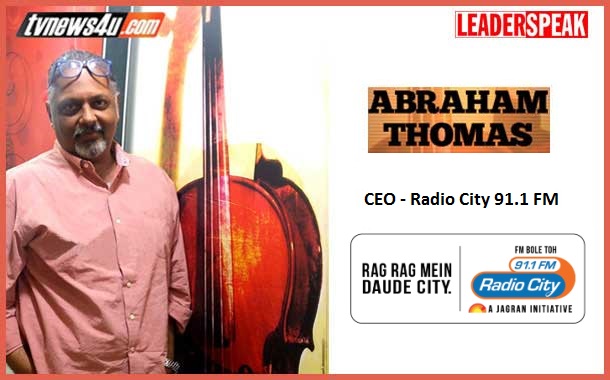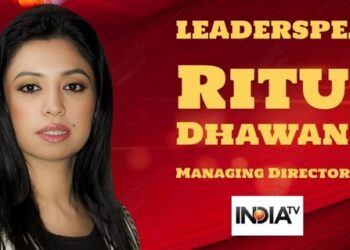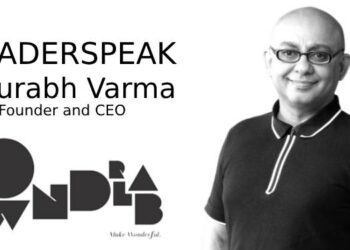“I don’t claim to be creative by any stretch but what I think I have now figured out is the ability to monetize creatives so it’s an ability to immediately connect brands with content and see how one can monetize that.”
That’s what Abraham Thomas, CEO –Radio City, one of India’s best M&E sales heads across print and television and over a decade now, business across Radio too, says in his disarmingly straightward way about himself.
TVNEWS4U.COM caught up with Thomas who, after seeing Red FM grow a 3-station network to a much larger one with a cemented place in the collective mindspace of radio lovers, moved on to launch Food Astro in India, and also handled NDTV Good Times, bee turning entrepreneur with short-mat content mobile devices bee coming back to FM Radio which, he admits after a young lifetime of experience across Media verticals, is his true love as a medium.
So welcome to the latest issue of LEADERSPEAK, yet another deep dive in our exclusive and popular insights–experience series. This time with brilliant M&E leader, Abraham Thomas. Dig in a long, leisurely, and rewarding read!
TVNEWS4U.COM: Okay, I am with Mr. Abraham Thomas. He is truly a veteran of radio and television and he is actually a business head who is inspired and thrilled by the sales part of life. So always a very safe bet to have when you have great above and below the line and you know top and bottom line that are critical your business. Abe, describe yourself.
Abraham Thomas: I am a… you are right! I’m a sales guy who began in media sales and walked the pavements and across markets and across cities and then I moved sales into brand, marketing and content… I don’t claim to be creative by any stretch but what I think I have now figured out is the ability to monetize creatives so it’s an ability to immediately connect brands with content and see how one can monetize that.
The other piece is I am very passionate about is media brands and I have had the opportunity to work with some really great media brands. All of them have great personalities and go beyond being just a functional brand with deep emotional connect — whether it was Sony or MTV or Red FM, or now Radio City.
Allow me to interrupt here. Many M&E heads are people who were bound elsewhere – professional education-wise. Were you always planning to enter radio?
Radio? I’m actually a qualified pharmacist, I did my B. Pharma! But post my MBA I’ve never worked in the pharma industry. I did my B. Pharma Mumbai University and MBA Pune. I have worked briefly in paints through my campus placement and also worked in retail a while. Got into media through the Indian Express and then never looked back.
So I began my career with the Indian Express, where I got a chance to work with multiple brands the Indian Express stable, Indian Express itself to Loksatta, Lokprabhat, to Screen to Financial Express to JanSatta – the whole gamut. I got the chance to really work closely with the content team there and drive marketing and then sales too, so that’s been my journey!
I spent a good 8 years at the Indian express starting off as brand manager went on to become head of circulation and distribution umm so that’s where the initial learnings of media happened in terms of getting the product out there! Then I moved to Ad Sales and worked on all the verticals of ad sales starting classifieds to tenders and notices and display advertising and finally with heading ad sales the Express group!
In 2000 I moved to Sony …
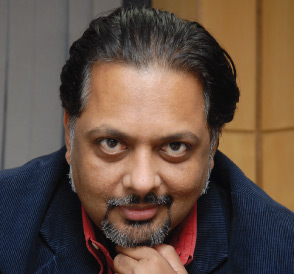
Sony Entertainment Television?
Yes, my first exposure to television. It was a great time to get into TV. I joined it on the same day as Mr. Bachhan premiered KBC — 3rd of July.
I was heading sales the network and it was a great time because well a lot of things happened in that period. At one level KBC was kind of moving and on another level there were a lot of other opportunities to work, so I also got a chance to work on the cricket property picked by Sony at that time!
Which was coming out on MAX…
Coming out on MAX! It completely changed paradigms because till then, Sports was always watched on a Sports channel and predominantly appealing to advertisers targeting males. the first time, because it was airing on a movie channel, we were able to get in a lot of advertisers beyond males and including families and kids! So again a very big paradigm shift in the ways sports was consumed, the amount of money one could write on sports as a genre. And what we started as just gone strength to strength. Now you see so many more innovations in content and new mats coming out on sports.
How long were you with Sony?
About three years
This is 2003. That’s when you moved, right?
Yes, that’s when I moved to MTV. Another great brand, a brand that gets a lot more mileage than the actual audiences it garners, purely on the strength of the brand.
Yes, it sells on perception more than actual numbers…
The brand clearly defines what its audiences are like. It was a great time when MTV was making that shift being a purely short-mat snacking channel to slightly more involving more engaging, long-mat content and a lot of big ticket properties. So that year we did the Style Awards, we did the MTV VMAs, which was the music award. MTV Roadies was something we launched then.
How long were you there?
I was there two years. And that’s when I got my first opportunity to get into general management when I joined Red FM as Chief Operating Officer.
Red FM happened in 2005?
Yes. Now Red FM at the time was a three-station network — Bombay, Delhi and Kolkata, and the next 5 years were like the best time in terms of the amount of stuff we did, the amount of change that we could bring in. Radio itself was just moving Phase 1 into Phase 2, which was far friendlier the broadcaster, and we moved radio into being a branded kind of play because every brand delivers a certain functional benefit, and the functional benefit was primarily music. See, the music content chosen was most often similar to what everybody else was playing — the same universal music. And while doing that, it was all about trying to create a differentiator to deliver an emotional benefit
Yes, that’s the brand personality…
And that’s how we came up with Bajatey Raho and the whole feel around it, giving it a certain tonality and bold treatment which is distinct. So we moved beyond music to that, and it was a great time we moved into a – it was a great team, amazing talent!
Who were the people with you in those days?
So a talent point of view, we had Mallishka and Mantra, in Delhi we had Nitin – great on-air talent. We also nurtured and groomed talent and at that time we also moved into beyond radio; we did properties outside — we did Bajatey Raho awards, we did events and activations, which created a larger play in terms of going beyond radio.
So all your marketing and promotions ultimately helped product distribution by getting the product in the collective mind space of people is also a strong push.
Absolutely, and it’s all about whether the content is accessed. See, whether the consumers are reaching out and pulling your content or whether you are pushing it to them, both have an important play
Correct
And, you are right — the main battle is reaching in the mind of the consumer! One thing I’ve seen is that a lot of times the media company believes that they are a platm, right? And a lot of them build their expertise on the logistics of the platm so their biggest focus is on distribution, on sales and on the technology to have it delivered – and their main offering and business is the content.
Today, a newspaper or TV news editor, you and I, we all receive all the news at the same time through social and digital. So how do I put it out to in a way that it becomes more interesting and engaging? And radio isn’t permitted to broadcast straight news bulletins. So I think the focus has shifted being a sales-distribution-marketing company to a being a content-creating company that continuously has to decide how to present the content. So I think the fundamental learning me is to clearly differentiate between content and platm.
Tell me more…
So content is what I play out through multiple platms — on the FM Radio, online, on-ground through multiple touchpoints, whereas my basic platm is the frequency and the technology and the transmission to different pieces…
With the overarching personality of the brand…
Yes, the brand kind of packages and creates that; unlike earlier, when it could be seen as one.
I think is an important shift because content consumption patterns have changed because of the technology and the kind of devices that are being used to consume the content and so even now when we see digitization all over and we see the rate at which devices and bandwidth are growing, the challenge is to make sure your content is relevant across these multiple platms so the same content will need to be purposed to suit the pipeline of delivery and the audience consuming it. It is actually all about relevance. You can’t take the same content and put it somewhere else.
Yes, like FM Radio, in the past, the audio TV commercials would be lifted and played out.
Oh yes! It goes beyond that now. So now the challenge is to create stuff that is engaging and relevant across every platm! So the same content cannot be used across multiple platms and interestingly the consumer consumption and the consumer habits were similar while they are different and they have changed, they are similar at a very basic level! So example current experience is showing that what people consume on digital online platm, music example is again playlists, and it’s about readymade playlists that you… which kind of go into an app and you kind of play out… and radio music are a playlist! You are creating a playlist that the users listen. It’s not about going and selecting and making your own playlist. People kind of say let me open the app let me listen to the playlist and it keeps playing on and on so that is actually radio.
Basic level is similar but it’s through devices that I am listening when I want to and its nonlinear so those are differences that exist but the basic premise of the consumption remains same, I want a playlist, I want to be entertained I am going to put it to play and now I am going to sit back and listen…
The emotional connect happens through the presenter and the attitude
Yes! Because the emotional connect is very very critical because that’s how you are known . I will listen to a certain brand of content because I know what to expect otherwise there is too much of content out there and if there is no consistency as to what to expect then I don’t know what the brand stands . So there branding and packaging is very different at a subtle level. A consumer is able to tell content across platms now in terms of saying, not across platms but content across competition.
How long where you at RED FM?
Close to 5 years.
And after that?
I was a consultant to Astro Group and they were into building media assets in India
The JV with Sanjeev Kapoor was on the anvil then, right?
Yes. They wanted a JV going with Sanjeev Kapoor to set up Food! Food! So I went into that as a project head, and I was supposed to conceptualize, create and launch the channel, so the next 7 years 12 months – 15 months kind of worked on the, scratch to building the whole team up to setting up the whole infrastructure and then launching the channel post which I worked with Astro on couple of their other investments like NDTV Good Times where I spent some time with them, get it to focus and other basically building their media assets in media as their consultant.
After that, I got into being an entrepreneur. So that’s when we actually set up an online short-m video company creating videos consumption on devices, and I did that another 2 years plus bee getting back into corporate with Radio City.
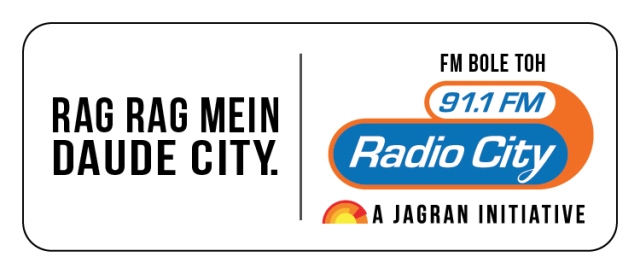
Radio City happened in end-2015, right?
Yes, in November, when I joined as CEO
So what happened? Apurva reached out to you?
Yeah! It was a conversation and then I said yes, there is an opportunity here because Phase 3 had happened, new stations were getting conceived and conceptualized, there was a real paradigm shift coming in with digital being an option the consumer and how one moves the brand into a multi-platm space. And one of the challenges of radio in the current m has been that they don’t have content!
That’s been its age-old problem, hasn’t it?
Yes, the main content on FM Radio is primarily the music, which they don’t own! It’s owned by the music labels. So now content needs to transcend across platms so that there is a need to create such content, and secondly, there is also a need the brand to get more sharply focused because that brand is what will drive the consumer pull platms. You will push your content out there! So there is both pull-generated content and push-consumed content!
So it looked like a very challenging prospect so I was like, sure why not!
Speaking of the content challenge, even on the advertising front, right since the early days, brands’ ad campaigns Radio were always an afterthought – it was usually the TV campaign audio rematted radio…
Yes. When I got into the early days of radio, television and agencies were actually very focused on television creatives, so the audio of a TV commercial was a standard jingle that was given to us, but all of us, all the radio players, actually went on and did a lot of hard work to build the category. We actually went to a few advertisers — retail and local – and took their briefs, created their spots and campaigns, went back, took their approvals and then played them. That’s how we got them introduced to the medium and that’s how the medium has grown over the last few years, and then I always felt that creativity in the radio platm has kind of reached a certain plateau. There was some standard thing that you had to a brand, whether it is a mention by the RJ or whether it is a contest on some element of integration.
Interestingly, I have worked on print, television and radio. In print, the line between content and commercial is very well defined by the dummy itself. This is our ad spot, this is our island ad and this is where content appears! Content inmation is well defined…
Television, also, excepting the in-program placements…
Yes, television is again defined. But there is a certain element of imprecision that you could take up in Radio, because it is live and it is local, and so the line between content and commercial is far more blurred. But it is a very important and crucial area. The consumer has become much smarter and he is aware that this is commercial and this is content, and he allows you that liberty of pushing some commercial his way, but it has to be done very sensitively, it has to be done just so, so that the credibility of the content stays intact.
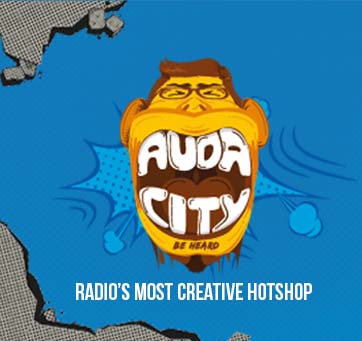
So how do you approach such opportunities or situations that need balancing the pulls of content integrity and plugs or mentions?
One of things we launched earlier this year is AudaCITY, which is our brand name our own in-house creative agency radio creatives. It comprises of the most experienced radio professionals including writers, who ideate and create solutions brands, and thereby helping them move beyond an RJ mention or a contest; we can actually create a 360-degree campaign the brand, and I am happy to say over the last few months we have actually done a lot of great work, we have created ideas where the content and the commercial are very smartly integrated, and working well the client and the listeners.
Any examples?
Quite a few. Recently we did the entire integration ‘Khatroon ke Khiladi,’ colors; we did the same Jhalak, and now ITC. A very memorable campaign around Mother’s Day was called ‘Mom’s Magic,– it was very nicely done where we got mothers and kids different markets on air, and they connect beautifully.
So there have been many nice, experiential, influential content themes the team has come up with, and I can confidently say that they were able to produce such great work only because they are Radio professionals, radio people who understand the power of the radio, the theater of the mind, and they are great creative professionals. Doing such good work on Radio, people who cannot understand the medium, is going to be impossible. Interestingly, that’s perhaps why a lot of agencies are now working with us with the approach: “Listen, you understand this field, this is our brand brief, you guys come with a solution.” That’s the level of their confidence in our delivery.
How long since AudaCITY began?
Some time in January this yaer.
So AudaCITY was one of your first initiatives after you joined them in November last year.
Yeah, one of the first things we did.
Do you have a specific team this?
Yeah, there is a core team and we have integrated that core team with the rest of the programming team. So my programming people across the country are utilized to brainstorm. example, if I need an idea to work in Gujarat, rather than my Mumbai team sitting and working on it, I can get my talent in Gujarat to work on it.
Makes eminent sense localization…
Yes. The idiom, the thinking, the language — it’s all integrated with programming, it’s not client solutions separately. Theree the talent across is making the difference and making it better; they understand and they come with real solutions easily.
The other thing that also affects is that there need to be other mats and innovations to make radio more interesting. There is also another thing we as an industry have not tried to accomplish, and that, to make radio easily accessible. It’s difficult to buy a radio transistor today right? Most stores don’t stock it anymore, so you get it on your mobile phone or in your car, which is great. In terms of buying, yes, but we have not done enough to evangelize the medium, we have not done enough to make the medium cool. Perceptually, radio is still a background, mantle-piece product playing.
So as an industry we really need to go out and evangelize the medium, it’s a really cool medium and without any real eft us, there has been huge consumption of radio through mobile phones — because it’s convenient and a lot of the big and low-cost devices have FM radio in-built. People are consuming it through mobile. So there is a need to go out and evangelize and make it cool, and it’s not just about the new generation that’s on mobile. The whole thing needs to get repackaged the current generation.
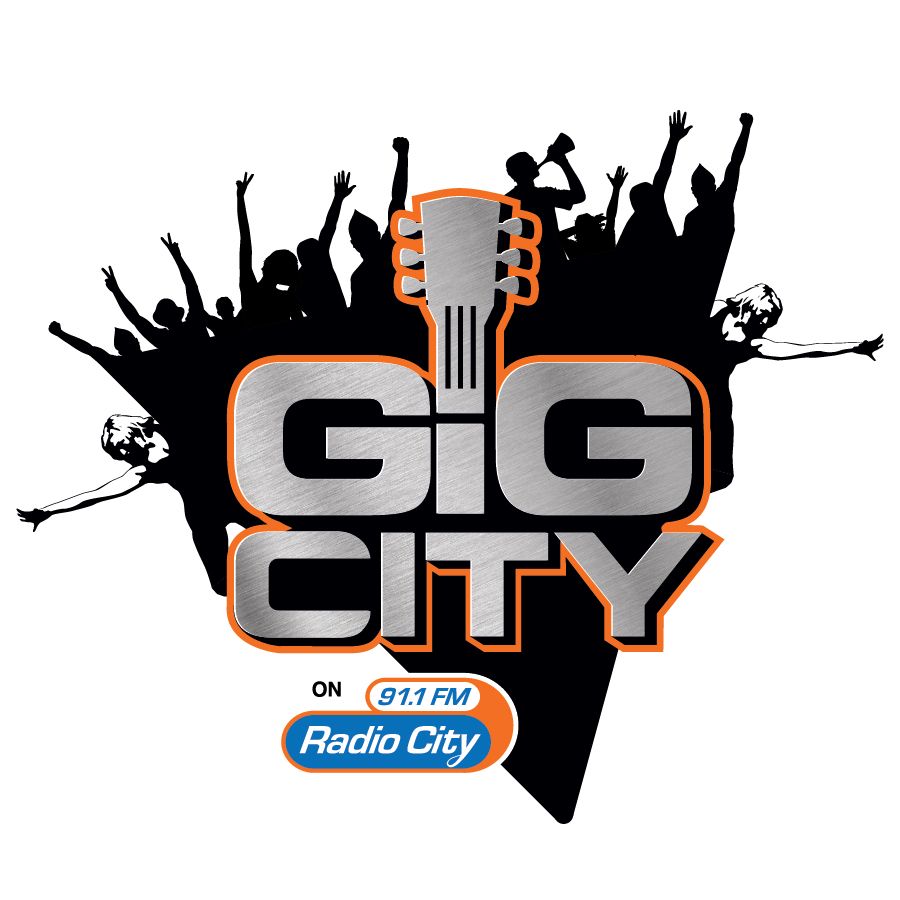
What is Radio City doing that?
We recently launched a property called Gig City. The concept is “Aap Jahaan, Concert Wahaan”. Not everybody has the facility to go out and attend a concert. So what we do is, we create a live concert feel on radio every Friday at 6 PM. There is a music concert live with some of the biggest music stars in the country. Season 1 of Gig City had 6 of the top music singers. We have Shaan, Farhan Akhtar, Shankar Ehsaan Loy, Salim Sulaiman and Ayushmann Khurana and Sunidhi. So all of them we have a two hour live concert every Friday at 6:00 PM, where they play pure Bollywood hits in front of a live audience. It’s a radio concert, so on radio you get the concert feel
Is this a network property played out on all stations?
Yes. We got great traction sponsors and we got great traction our own listeners. I think this is a mat breaker. I am listening to popular songs that I know, but live, with a live feel. There are improvisations, there are parodies, there are crowd interactions, and it’s like being part of a concert, and you can do it wherever you are. You can be part of an audience at home, in the car, through your mobile phone.
Artist Aloud Hungama started such concerts on video years ago, but taking them on a major FM Radio network like Radio City, on a network level and with such rich interactive content, and with well known music-and star permers is a big move ahead.
Thanks. In fact, more such innovative mats will make radio more engaging and bold. It’s not about listening to just music; it has to be music-plus. So similarly, now we are looking at another innovation which is a combination of on-ground, online and on-radio to break mats and create new content. One is in the user generated space and one is in the comedy genre.
We have launched a very interesting property. Actually, the learning actually came Gujarat, where they launched something called the Joke studio. They have a very popular local comedian and do the show on Saturdays, and then they took him on-ground where he would the same thing across the city. Now we have 3 to 4 local comedians coming in and doing it. So now it’s become a very good property where now Saturday is called ‘Funnyvar’.
You mentioned comedy earlier too. Are you building on it as a genre?
Yes, we are building on comedy as a genre and using local talent. So it’s not established talent but local talent. This is a property now that is going national. We are launching this across markets. We have launched it in Delhi as well. So it’s a new genre, it’s interesting it works on audio and it becomes a property that will give you entertainment beyond music.
The thought is to build such mat breakers across different markets and across different geographies. And our role is to bring the advertiser and listener together. If the advertiser can smoothly and smartly integrate it, it works best everyone.
On the set FM Radio mats — the thing that guts me is the cast in stone mat where the RJ comes on, does a quick 15-20 seconds link which is always prerecorded because it is always so flawless without a slip and hence totally unnatural, but we can let that pass. Smoothness is OK. But what is not, to my mind, is that it’s always like, no link will be longer than 15 to 20 seconds, cut to song or a break or an ad or whatever! Where has conversation gone? I’m not pointing at Radio City, but FM Radio in general. When Meow FM came up it was great, though they often pushed conversation lengths to the other extreme where they would talk 3-4 minutes bee a song came on, and that definitely was a drag. But the conversation was far better. Then there were Jaggu and Tarana on Radio One, who were brilliant. What’s happened to conversations?
Our primary role is to ignite conversation, say stuff that is thought provoking, whether someone personally calls up and chats or if the rest of them chat because of the conversation that is happening. It’s a challenge and it can’t be about just being articulate or being funny. It has to kind of provoke thinking and make the listener say, ‘Hey I never thought of that!’
Yeah, so somebody who knows radio and understands it, can often realize that this thing which went off so smoothly is actually pre-recorded by the guys in the studio. But why is it that 20-seconders are still persisting as the norm across radio industry?
It currently seems to work. In a mature market with many competitors, everyone wants to be amongst top three. Question is, who would go after that largest bucket, which is popular music and talent, and put the whole thing together. It’s only then the others are ced to innovate and find new slots, only then they will say ok, let me not be a fifth player, but create a new space and do it. That is beginning to happen, and now you’re seeing different genres being targeted by different players.
The point is that the advertising money is also being distributed accordingly. While there are premiums that you will get being a niche player because you have more premium audience there, that money should also correlate to the absolute money that is there. Which is why that mad rush to be in the top 3-4. Only after these slots are taken is when the other realize, OK, now that these slots are taken, let me either differentiate by language or mat.
Or in Phase 3 get another station?
Yeah, or get new stations and differentiate there.
What are your Phase 3 plans? How many stations do you currently have?
We are currently in a total of 28 cities, with Radio City in 20 cities and Radio Mantra in 8. Now we have another 11 stations being launched by end of the year.
Which cities?
We have not taken duplicated second frequencies; they are all in new markets. We are the largest in Maharashtra, we are driven by a couple of strategic initiatives saying let’s go across in markets where we have a strong presence. So our big markets include Kanpur, Patna, a few stations in Maharashtra, Rajasthan, Punjab and Haryana.
What about radio and print, regional print, they both make the play the same advertiser (local advertiser) in a big way. How do you keep them both separate? Or is there a common sales team that tries to go and sell both as an integrated package and take money. That would reduce your average spend on radio right?
No, we have a healthy number of new businesses that come on regularly to radio, which could go to print or which already exist in print. The set of advertisers in radio is the subset of advertisers on print, and there are certain numbers who also graduate to radio. Both mediums have their own strengths so you can’t replace one with the other.
So you have two different teams like marching ants print and radio that go out and do a strong play the same money? Same advertisers?
Currently it’s not necessarily the same money, but yes there are separate teams that do it. We are open to doing integrated deals as well clients who are looking at that. There are a lot of synergies we are currently exploiting.
So what are the challenges, if any, that you are facing, given that you have come on just under a year back, but the print giant Jagran has been around decades and with great strength in ad sales in the markets. How does your Radio City ad sales team go out and bring in the advertisers?
See, it’s not about me but about Radio City being a top player in every market and having a good market share. We also have a solid sales team along with great practices and processes. There, they are as excellent at monetizing radio. There are completely different teams.
Every radio leader I speak with, the problem of measurement comes up. The need to sell on perception, use your own research the various research shops running. As an industry leader, Abe, what is it that needs be done measurement?
Measurement is critical to build credibility to the medium. We have grown over the last so many years, because measurement has been available in some m or the other. Having said that there is always a debate about accuracy versus cost. The other challenge is that currently all the measurement is done differently. Unless the measurement is electronic, it is invariably capturing the top-of-mind — whether it is a diary method, where people are not filling it on the go, but at the end of the day or a week. It comes down to top of mind. Theree the current measurement is skewed towards measuring top of mind rather than actual listenership. Till we get into electronic measurement you will always get recall and top of mind scores rather than actual listenership.
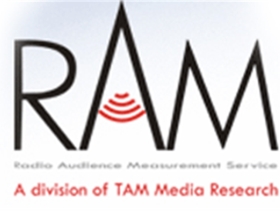
So if you had to go out and get that electronic measurement, how would that be? How will it be executed?
There are technologies available, where there are devices that you can wear, that can actually measure what you are listening to and when. Which is different a diary method or questionnaire method, which asks you – what did you listen to on Monday between 7:00 and 7:15 in the morning? It’s definitely possible. Although like I mentioned there is debate between cost and accuracy, but we have to move ward. RAM was a great beginning around 8 to 10 years ago. RAM has been great and it was a step up. I know it was some of the leaders who actually came in and ced the entire thing.
If we have to grow the medium and move ward, it’s time we took the next step. It’s not about going 100% electronic, because there is a cost to it, and you can’t support that kind of cost with the kind of revenues that the medium is getting. But you have to move ward, even if it’s not continuous measurement, if you can have even 4 or 6 measurements in a year, it’s still progress. In research the trends are always accurate. If you look data over a certain period of time you can get a slightly more accurate feel of what’s happening. I think it’s imperative that we move towards more measured cities and more measured data. I think that’s the only way to grow the advertising pie.
So if RAM comes up with the new measurement, will you be willing to go along with them? Do you subscribe to RAM?
Yes, we do subscribe to RAM, and we also do a very intense research across every one of my markets every month. We get a track of top-of-mind and intention-to-visit. It’s our brand track and is used extensively to decide on programming and marketing – we check what is working and what is required. It’s a very robust internal system that we have built to help us in our own decision making.
Whom do you do this with?
We do it with AZ research. It’s very interesting robust data that they collect over months, which helps our brand track.
I think it is imperative the industry to get really wide and deep and far more frequent with its research and measurement, if you want to grow. You cannot keep doing it only on perception, because then the question the advertiser will ask himself is, ‘how much money am I willing to put into a medium which is not going to give me data?’ One of the biggest challenges Digital is that when all kinds of data is possible about listenership that is happening on the online digital media, there is need to know where did our listeners come , where did they go? All that is possible given that it is digital data. And that’s not sampling-based; it is every single consumer, whom you have that data. radio the biggest challenge other than the tech itself is the data it gives the advertiser.
Right now volumes are low, which is why the advertising on it is low, but the issue of the quantum or wealth of data and info that it gives you – that is something we as an industry need to rise up and address, because in the absence of data it’ll be all about perception, and about “okay, I’ll put in a small percent of my money on radio.” If you don’t move into research you’ll get more and more handicapped.
So ultimately, there are these four cities that RAM measures, and then there is every network that is fending itself getting an Ormax or some other good research agency like it, to measure its permance and perception.
That’s right. And these are the larger networks which are doing this. And this is where we need slightly more maturity amongst the industry itself — that it is not about misleading or perception-creating communication. Realistically the media planners and buyers don’t look at that data. When you start claiming that you’re Number 1 during this time on this day in this market or wherever else, it is not being used to plan anything while buying the media. You have to grow beyond that to say I want to assure you to spend money on this medium. I want to assure you with backup data. Look, this is how your campaign did.
I think there are ways to do this. It’s not about going 100% electronic or 100% of the markets, but it’s about clearly having a plan saying “okay, this is how we’ll address these markets and we’ll kind of get more robust in these markets”
So you radio business leaders, would you be getting together through AROI? What is that you guys are planning to do?
Currently there is some movement to address this whole measurement issue and I think we will get somewhere with that.
Ok, a hypothetical question – of ARPO were to tell all its members that there’s x amount of contribution that is linked to the percentage of your turnover, or an absolute number in slabs according to your network size and turnover, that every member has to contribute to bolster the industry on measurements so an Indian or international measurement partner can be hired to start measurement of FM Radio listenership in right earnest, with width, depth and across listening platms if possible. And the numbers will available to radio operators and all marketing agencies and brands that want to subscribe to them. If measurement through that route were an option, and assuming that the networks happier in the absence of measurement and using only perception to sell, would somehow agree to it, would you go it?
I believe in it and think it should be done. But there has to be consensus. A lot of players have revenues driven by perception. Some by reach, many are driven by larger sales teams. So those who have their mulae will want to stick to them. The important thing theree is to get consensus. There is some interest now, especially after the BARC experiment. Everyone agrees there is a need to evangelize and grow the industry and its reach, but consensus is the need of the hour; it needs to come.
What is the advertising split like on FM Radio now – strategic to tactical, national to local…?
Local advertising has really grown. Earlier it was 75% national, 25% local. Today in some markets it’s 50-50, and in some markets local outstrips national. This is due to two things. One is that there are new marketers and advertisers who are entering the market. Real Estate continues to be a top category; education seasonally continues to be a top category. So a lot of local retail advertising such as wellness etcetera has grown. Parallelly, a lot of large brands are realizing that a one-size-fits-all national communications strategy is not the best thing to do. Radio offers local creatives and strategies. National brands are now using different radio plans and creatives across markets, so local is definitely growing.
So strategic national campaigns are getting a tactical local sheen?
It works the brand, the medium.
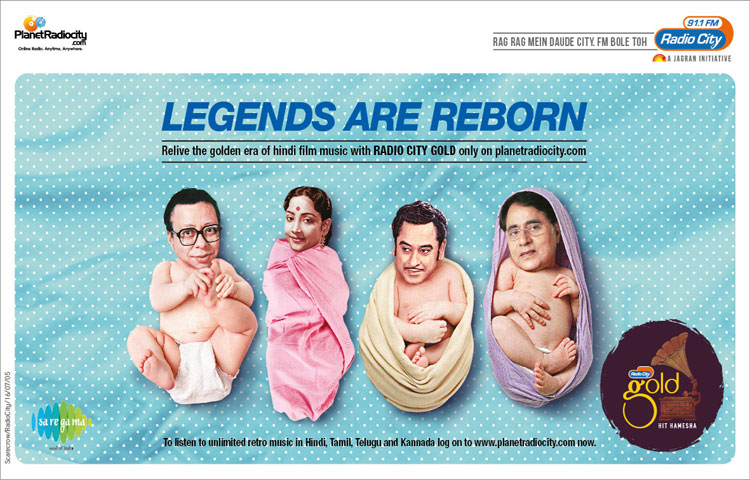
What about talent? How will Planet Radio City Gold woo youngsters with old music? What will your approach be?
We believe that the world over there is an audience older music, so even if you present it to them in a manner and device on which it can be consumed, a lot of that music will excite them. There is the nostalgia audience that grew up on this music, and then there is a new audience which needs to be exposed to it. Which is why digital is a great way to go, because that audience is not a radio listener necessarily. We’re creating interesting playlists, live radio. So we’re very optimistic, and it’s our understanding of the audience because of which we are the only music station taking retro online. We can see that directionally there is a revival in old music. So we said, let’s present it to them in their space and preference.
So you can target the Nashas and the REDtros with this strategy?
The older audiences and true retro lovers are getting fragmented now, because earlier there were no dedicated retro stations; now that one station has started, the others are starting as well. Our task is to try and also present this to newer audiences. Which is where we think that Planet Radio City is a big winner with cross-promotions. The task is to get to audiences who are not conventionally tuning into radio. Our terrestrial show ‘Kal Bhi Aaj Bhi’ is being integrated with PRC Gold. So lots of activities to give it traction.
And on the other side of the mic, the talent? What’s the scenario like?
Well, there’s the talent that has come and become a brand within itself, having created a name. While the challenge is always always to find newer talent the new crop, the challenge the existing talent is to remain relevant. Audiences have grown up. Someone who was 24 ten years ago is now 34, so you don’t expect him to react the same way. The person who was 14 ten years ago is now 24, and the entire paradigm has changed. What’s vital is that existing talent needs to stay current.
Radio City has its own school where we give people practical and theoretical training; it’s a new pipeline of talent. They come train with us, get access to our studios and creative rooms, and then we cherrypick them depending upon the requirement. There are small, handpicked batches.
At the last internal annual awards, you said 20-25 people were awarded completing a decade with you. What’s the attrition like?
I think we have very strong HR practices, and have been ranked among the Great Places to Work, very robust HR, attrition very low, in fact I would say lowest in the industry.
You have much the same set of presenters in your drive prime slots. People like Archana Pania are excellent, and she is one presenter who has remained ‘young’ in her style and delivery and has remained connected with the younger audiences. So where do you try new talent? Obviously you can’t test or blood anyone in a Drive Prime slot, but …
Our attempt is always to keep new talent — some people turn up as seemingly great producers, but end up being great (on-air) talent. We’re ever on the lookout. The cue to existing talent is to stay relevant. Today social media being what it is, stay ahead of the curve. There are a lot of radio listeners on social media as well as digital audiences. Now the overlap is increasing. Progressively, people are wired and connected more and more. The play has to change.
How are you promoting Planet Radio City Gold?
We do extensive cross promotions. There are certain audiences who are sold on the content, the music they grew up on, but the new generation didn’t get a chance to get exposed to it, because Sa Re Ga Ma stopped publishing LPs.
Our research is finding a lot of interesting stuff. Like a lot of people say, “I used to listen to this music with my Dad”; there is that nostalgia element. The second thing is a lot of that music is timeless. A ‘Chura Liya Hai’ is timeless, so our efts are to present that to this audience.
So what is the approach? People who were born say in 2000, they haven’t grown up on older music, so when someone comes to you looking a job, what is it that you look in that person?
Some of the best people I’ve hired are pubs and parties. Radio is about spontaneity. One guy in a party is usually animatedly talking and 5-6 others hanging around enjoying it — that’s the guy to get! The challenge is, a lot of people freeze in front of a mic, or they become scripted and conscious. Don’t believe that someone with radio experience is necessarily the best. Relevance is the key. That’s the kind of people we look – the culture, the values – we make sure that people’s needs across work-life balance are met.
So what kind of people fit in?
It isn’t one-size-fits-all. It’s a combination of people who will continue steady and get better. There are some people who you are expecting who are disruptors and who think out of the box. Integrity is very important and it cannot be compromised at all. That is the culture we are built on at Radio City.

